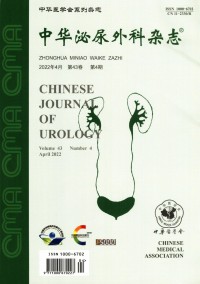超小型经皮肾穿刺取石术(SMP)治疗成人和儿童上尿路结石的疗效评价
Q4 Medicine
引用次数: 0
摘要
目的比较全超声引导下超小型经皮肾取石术(SMP)治疗成人和儿童(<14岁)上尿路结石的安全性和有效性。方法自2015年5月至2018年7月,81例(53%)儿童和71例(47%)成人上尿路结石患者在全超声引导下接受SMP检查。儿童组男53例,女28例,共85个通道,年龄10个月~14岁[平均(56.0±39.7)个月],结石大小0.8~3.5cm[平均(1.7±0.7)cm],输尿管上段及肾盏结石1例,双肾盂及输尿管畸形1例。尿路感染率为86.4%(70/81),尿路培养阳性率为39.5%(32/81),其中男性43例,女性28例,年龄18~81岁,[平均(44.1±15.4)岁],结石大小1.0-3.0cm,[平均值(1.7±0.6)cm],肾盏结石7例,输尿管上段结石24例,输尿管上端及肾盏结石3例,双肾盂输尿管畸形1例。尿路感染率为87.3%(62/71),尿路培养阳性率为26.8%(19/71)。患者在全身麻醉下置于切开取石位。将5F输尿管导管逆行插入收集系统,并将导尿管放入膀胱。患者随后俯卧。在18G穿刺针的超声引导下对选定的杯状物进行穿刺,并将0.032英寸的导丝插入收集系统中。使用扩张器建立肾造瘘道(12F分一步进行,14F分两步进行)。放置相应尺寸的抽吸抽气鞘后,通过金属连接器的倾斜分支将鞘连接到样本采集瓶。将微型内窥镜插入鞘内观察收集系统,并使用YAG激光或气压弹道碎石机完成碎石。术后1天(SFR)和1个月(SFR 1个月)的结石清除率、结石大小、手术时间(从开始碎裂到手术结束)、术后第一天血红蛋白下降和红细胞压积下降、手术并发症发生率、无管率(完全无管:无输尿管支架和肾造瘘管;无管:没有肾造瘘导管但有输尿管支架),记录并比较平均住院时间和尿路感染情况。结果儿童组平均手术时间为(27.7±13.0)min(5~60min),1个月时SFR和SFR分别为96.3%(78/81)和98.8%(80/81),平均血红蛋白下降为(8.0±9.1)g/L(0~41g/L),平均红细胞压积下降为0.026±0.029(0~0.135),完全无管率为86.4%(71/81)。观察并发症9例,采用Calvien分级系统进行分类,Ⅰ级8例:术后发热4例,积血1例,肾周血肿,术后输尿管远端结石1例,肠功能延迟恢复1例,均为自发恢复,无特殊处理;Ⅲb级1例,术中发现大量腹水,经穿刺引流治愈。成人组平均手术时间为(31.2±15.3)分钟(范围7-80分钟),1个月时SFR和SFR分别为97.2%(69/71)和98.6%(70/71),平均血红蛋白下降为(11.9±8.7)g/L(范围0-32 g/L),平均红细胞压积下降为0.030±0.027(范围0-0.106),完全无管率为87.3%(62/71),平均住院时间为(2.4±1.1)天(范围1-8天),尿路感染率为87.3%(62/71,尿培养阳性率26.8%(19/71),并发症4例,Ⅰ级3例,2例出血,1例肠功能恢复迟缓,均为自发恢复,无特殊处理;Ⅲb级1例,术后输尿管远端结石1例,经输尿管镜碎石术治愈。结论超小型经皮肾镜取石术具有安全、有效、快速恢复的特点,可作为成人和儿童上尿路结石的首选治疗方法。关键词:肾造口术,经皮;超小型经皮肾取石术;上尿路结石;成人和儿童;无管本文章由计算机程序翻译,如有差异,请以英文原文为准。
Evaluation of super-mini-percutaneous nephrolithotomy(SMP) for upper urinary stone of adults and children
Objective
To compare the safety and efficiency of totally ultrasonography-guided super-mini-percutaneous nephrolithotomy(SMP) in the treatment of upper urinary stone in adults and children(<14years).
Methods
From May 2015 to July 2018, 81 cases of children(53%) and 71(47%) cases of adults with upper tract stones underwent the SMP by total ultrasound guidance. In the group of children, it’s including 53 male and 28 female with 85 channels in total, the patients age ranged from 10 months to 14 years, [mean (56.0±39.7) months], The stone size ranged from 0.8-3.5 cm, [mean (1.7±0.7)cm]. About stone distribution, 42 cases of pelvic stones, 25 cases of calyceal and pelvic stones, 5 cases of calyceal stones, 7 cases of upper uretaral stones, 1 case of upper ureteral and calyceal stones, 1 case of malformation with double renal pelvis and ureter. Urinary infection rate was 86.4%(70/81), positive rate of urinary culture was 39.5%(32/81). In the group of adults, it’s including 43 male and 28 female, the patients aged from 18 to 81 years, [mean (44.1±15.4)years], The stone size ranged from 1.0-3.0 cm, [mean (1.7±0.6)cm]. About Stone distribution, 19 cases of pelvic stones, 13 cases of calyceal and pelvic stones, 7 cases of calyceal stones, 24 cases of upper uretaral stones, 3 cases of upper ureteral and calyceal stones, 1 case of malformation with double renal pelvis and ureter. Urinary infection rate was 87.3%(62/71), positive rate of urinary culture was 26.8%(19/71). The patient was placed in the lithotomy position under general anesthesia. A 5F ureteric catheter was retrogradely inserted into the collecting system and urethral catheter was placed in the bladder. The patient was then turned prone. The selected calix was punctured under ultrasound guidance by 18G puncture needle and a 0.032 inch guidewire was inserted into the collecting system. Nephrostomy tract was established using Dilators(it was done in one step for 12F and in two steps for 14F). After the corresponding size of suction-evacuation sheath was placed, the sheath was connected to the specimen collection bottle via the oblique branch of a metal connector. The miniature endoscope was inserted into the sheath to observe the collecting system and stone fragmentation was completed by using YAG laser or pneumatic lithotripter. Stone free rate after surgery at 1day(SFR) and 1 month(1 month SFR), stone size, operative time(from starting fragmentation to the end of the surgery), hemoglobin drop and hematocrit drop in the first day after surgery, rate of surgecal complications, tubeless rate(totally tubless: no ureteric stent and nephrostomy tube; tubeless: no nephrostomy tube but ureteric stent), average length of hospital stay and urinary infection were recorded and compared.
Results
In children group, mean operative time was (27.7±13.0)min(range 5-60 min), SFR and SFR at 1 month were 96.3%(78/81)and 98.8%(80/81), mean hemoglobin drop was (8.0±9.1)g/L(range 0-41 g/L), mean hematocrit drop was 0.026±0.029(range 0-0.135), totally tubeless rate was 86.4%(71/81), mean hospital stay was (2.5±0.9)days(range 1-5 days). Complications were observed in 9 cases and classified using Calvien grading system, Grade Ⅰ in 8 cases: postoperative fever in 4, hematuresis in 1, perirenal hematoma, postoperative distal ureteral stone in 1 cases and delayed recovery of intestinal function in 1 case, all had a spontaneous recovery without special managements; Grade Ⅲb in 1 case, massive ascites was discovered during the surgery, and rcovered by puncture drainage.In adult group, mean operative time was (31.2±15.3)min(range 7-80 min), SFR and SFR at 1 month were 97.2%(69/71) and 98.6%(70/71), mean hemoglobin drop was (11.9±8.7)g/L(range 0-32 g/L), mean hematocrit drop was 0.030±0.027(range 0-0.106), totally tubeless rate was 87.3%(62/71), mean hospital stay was(2.4±1.1)days(range 1-8 days), urinary infection rate was 87.3%(62/71), positive rate of urinary culture was 26.8%(19/71). Complications were observed in 4 cases, Grade Ⅰ in 3 cases: hematuresis in 2 and delayed recovery of intestinal function in 1 case, all had a spontaneous recovery without special managements; Grade Ⅲb in 1 case, postoperative distal ureteral stone in 1 cases and cured by ureteroscopic lithotripsy. According to data about Hb drop, risk of hemorrhage is lower in children than adult significantly(P 0.05).
Conclusions
With the characteristics of safe, efficacious and rapid recovery, super-mini-percutaneous nephrolithotomy(SMP) can be used as the first choice of the treatment for upper urinary stone both in adults and children.
Key words:
Nephrostomy, percutaneous; Super-mini-percutaneous nephrolithotomy (SMP); Upper urinary stone; Adults and children; Tubeless
求助全文
通过发布文献求助,成功后即可免费获取论文全文。
去求助
来源期刊

中华泌尿外科杂志
Medicine-Nephrology
CiteScore
0.10
自引率
0.00%
发文量
14180
期刊介绍:
Chinese Journal of Urology (monthly) was founded in 1980. It is a publicly issued academic journal supervised by the China Association for Science and Technology and sponsored by the Chinese Medical Association. It mainly publishes original research papers, reviews and comments in this field. This journal mainly reports on the latest scientific research results and clinical diagnosis and treatment experience in the professional field of urology at home and abroad, as well as basic theoretical research results closely related to clinical practice.
The journal has columns such as treatises, abstracts of treatises, experimental studies, case reports, experience exchanges, reviews, reviews, lectures, etc.
Chinese Journal of Urology has been included in well-known databases such as Peking University Journal (Chinese Journal of Humanities and Social Sciences), CSCD Chinese Science Citation Database Source Journal (including extended version), and also included in American Chemical Abstracts (CA). The journal has been rated as a quality journal by the Association for Science and Technology and as an excellent journal by the Chinese Medical Association.
 求助内容:
求助内容: 应助结果提醒方式:
应助结果提醒方式:


